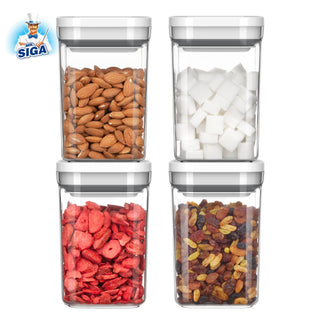In the quest for convenience without compromising on the quality and safety of our food, selecting the right food container for transportation becomes a crucial decision. Whether you're packing a lunch for work, prepping meals for the week, or organizing a picnic, the container you choose can make a significant difference. This blog post aims to guide you through the maze of options, helping you make an informed choice that keeps your food fresh and tasty, and aligns with your lifestyle needs.
The Importance of Choosing the Right Container
The right food container does more than just hold your food; it ensures its freshness, maintains its temperature, and prevents any leaks or spills. Moreover, in an era increasingly conscious of environmental sustainability, choosing a reusable and durable container can reduce your carbon footprint significantly.
Types of Food Containers and Their Best Uses
1. Plastic Containers: The Lightweight Choice
Plastic containers are popular due to their lightweight nature and durability. They come in various sizes and shapes, making them versatile for different food types. However, it's crucial to choose BPA-free plastic to avoid chemicals leaching into your food. Plastic containers are ideal for dry foods and less oily meals. Remember, though, they can retain odors and stains from strong-flavored foods.
2. Glass Containers: The Eco-Friendly Option
Glass containers are the champions of sustainability and health. They don't absorb smells or stains and are perfect for storing and transporting both hot and cold foods. Glass is microwave safe, making it convenient for reheating meals. The downside? They're heavier and more fragile than their plastic counterparts.
3. Stainless Steel Containers: The Durable Pick
For those looking for durability and longevity, stainless steel containers are your best bet. They're robust, eco-friendly, and ideal for keeping food cold or hot for extended periods. However, they're not microwave-safe, and their weight can be a consideration for daily transport.
4. Insulated Containers: Keeping Temperatures Steady
Insulated containers are designed to maintain the temperature of your food, be it hot or cold, for hours. They're perfect for soups, stews, or cold salads. While they offer excellent temperature retention, they can be bulkier and more expensive than other options.
5. Silicone Bags: The Flexible Alternative
Silicone bags are a relatively new entrant to the food container scene. They're lightweight, flexible, and can be sealed airtight, making them excellent for storing a variety of foods. They're reusable, easy to clean, and a great choice for those looking to reduce their use of disposable plastics.
Factors to Consider When Choosing a Food Container
When selecting the right container for transporting food, consider the following:
- Food Type: Oily, soupy, or saucy foods require leak-proof and airtight containers, while solids might be okay in something less secure.
- Durability and Safety: Opt for containers that are crack-resistant and made from food-safe materials.
- Ease of Cleaning: Look for containers that are dishwasher safe to save time and ensure hygiene.
- Portability: Consider the weight and size of the container, especially if you'll be carrying it around.
- Environmental Impact: Reusable and recyclable materials are better for the planet.
The Verdict
There's no one-size-fits-all when it comes to the best food container for transporting meals. Your choice depends on the type of food, personal preferences, and environmental considerations. Glass containers are excellent for those prioritizing health and sustainability, while stainless steel offers unmatched durability. Plastic remains a lightweight and versatile option, and insulated containers are unmatched for temperature control. Meanwhile, silicone bags offer a flexible and eco-friendly solution.


apvvlntvhk
Muchas gracias. ?Como puedo iniciar sesion?
yxxdhrskuz
Muchas gracias. ?Como puedo iniciar sesion?